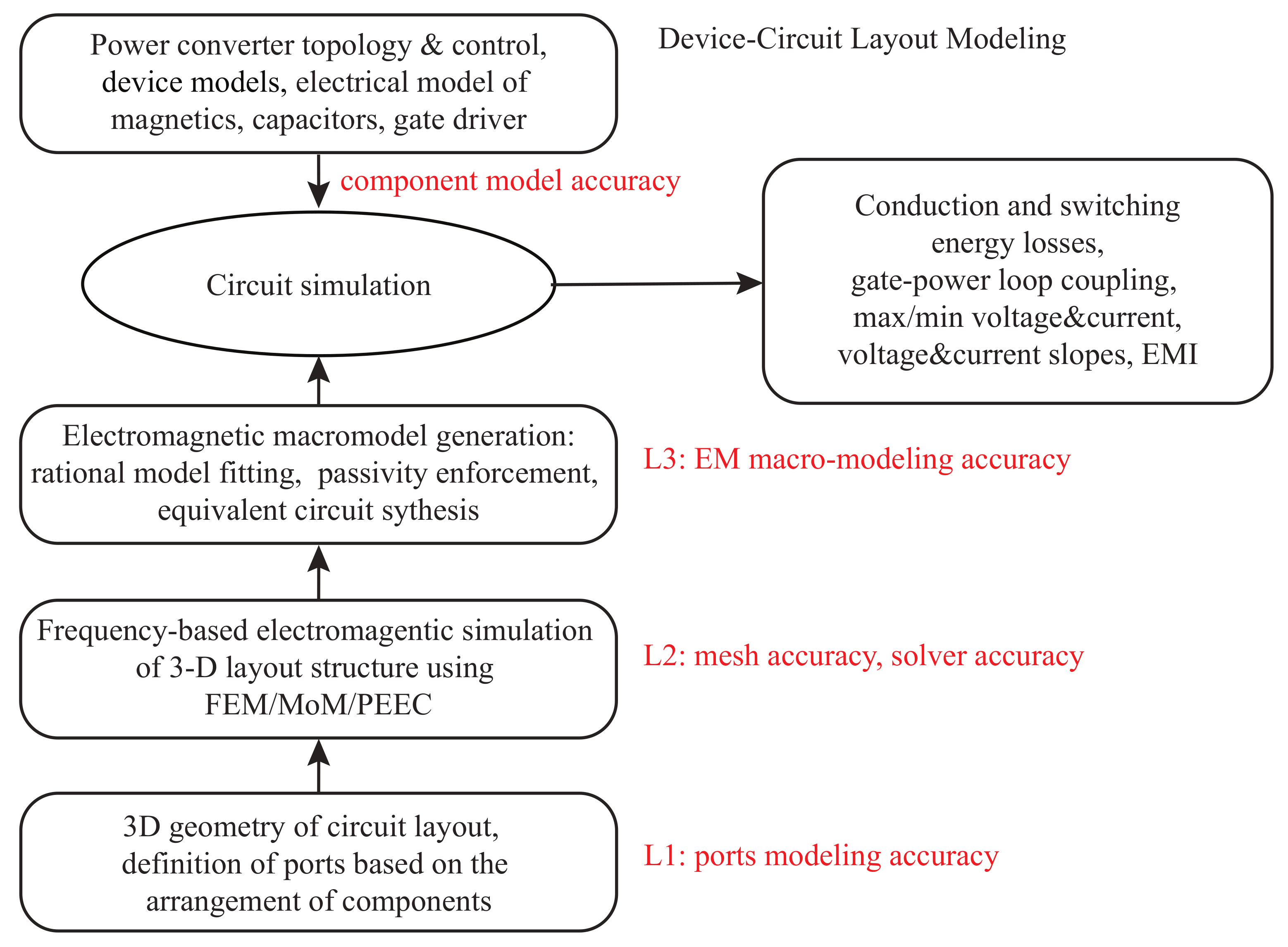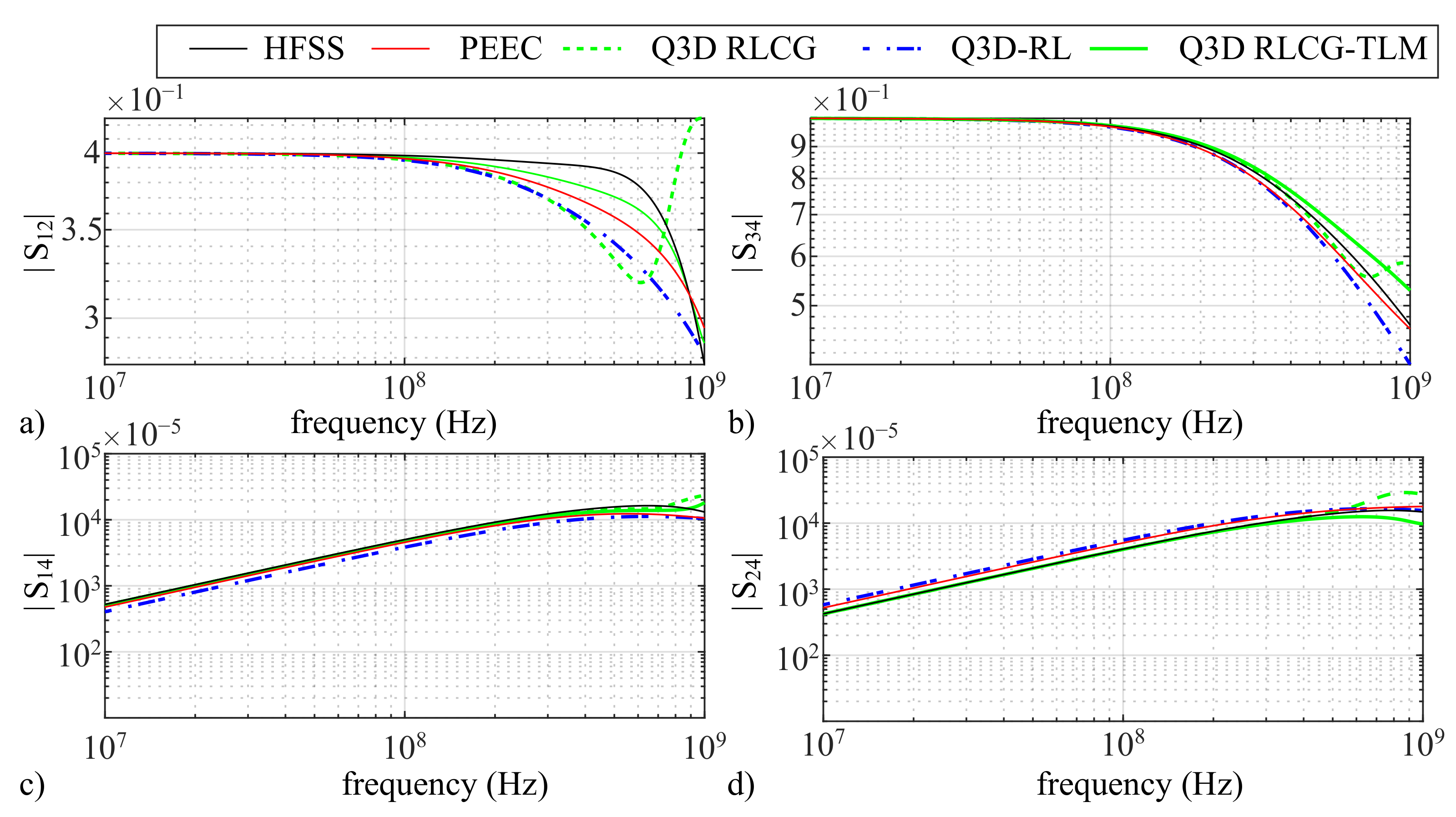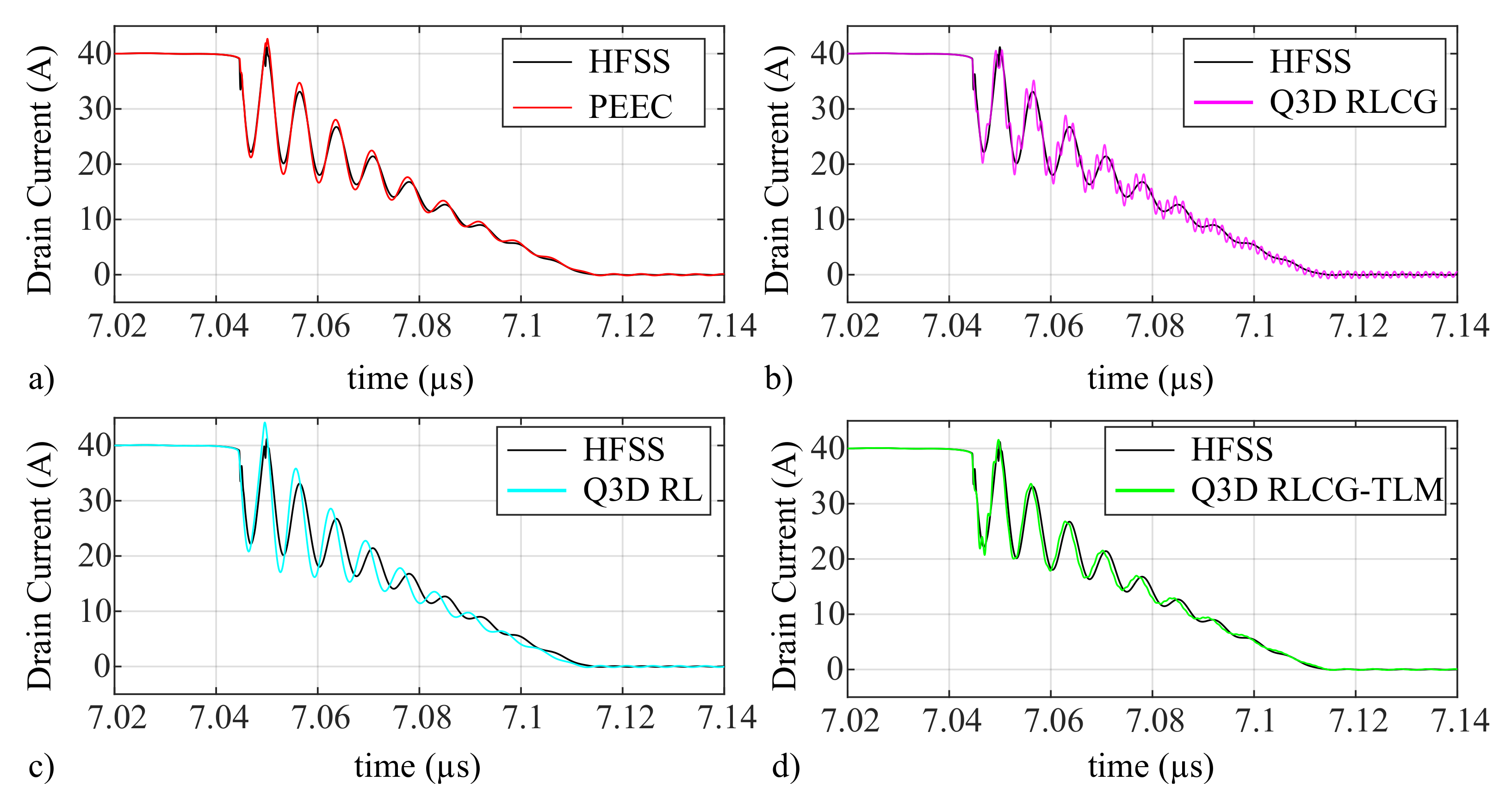Broadband Circuit-Oriented Electromagnetic Modeling for Power Electronics: 3-D PEEC Solver vs. RLCG-Solver
Abstract
1. Introduction
2. The State-of-the-Art Device-Circuit Layout Coupled Modeling
2.1. Time Domain EM Macromodeling
2.2. Frequency Domain EM Macromodeling
3. Circuit-Oriented 3-D Electromagnetic Modeling
3.1. 3D-PEEC Solver
3.2. RCLG-Solvers
3.3. Comparison between FEM-, RLCG- and PEEC-Based EM Modeling
3.3.1. Ports
3.3.2. Mesh
3.3.3. Resulting S-Parameters
4. Device-Circuit Layout Coupled Simulations
4.1. Example 1
4.2. Example 2
4.3. Results Analysis
5. Conclusions
Author Contributions
Funding
Conflicts of Interest
Abbreviations
| MDPI | Multidisciplinary Digital Publishing Institute |
| DOAJ | Directory of open access journals |
| EM | Electromagnetic |
| PE | Power electronics |
| PES | Power electronic systems |
| HF | High Frequency |
| LF | Low Frequency |
| SiC | Silicon Carbide |
| PEEC | Partial Element Equivalent Circuit |
| FEM | Finite Element Method |
| 3-D | three-dimensional |
References
- Liu, T.; Wong, T.T.; Shen, Z.J. A new characterization technique for extracting parasitic inductances of SiC power MOSFETs in discrete and module packages based on two-port S-parameters measurement. IEEE Tran. Power Electron. 2018, 33, 9819–9833. [Google Scholar] [CrossRef]
- Lemmon, A.; Graves, R. Parasitic extraction procedure for silicon carbide power modules. In Proceedings of the 2015 IEEE International Workshop on Integrated Power Packaging (IWIPP), Chicago, IL, USA, 3–6 May 2015; pp. 91–94. [Google Scholar]
- Shahabi, A.; Lemmon, A.N. Multibranch Inductance Extraction Procedure for Multichip Power Modules. IEEE J. Emerg. Sel. Top. Power Electron. 2020, 8, 272–285. [Google Scholar] [CrossRef]
- Mukunoki, Y.; Nakamura, Y.; Konno, K.; Horiguchi, T.; Nakayama, Y.; Nishizawa, A.; Kuzumoto, M.; Akagi, H. Modeling of a SiC MOSFET with focus on internal stray capacitances and inductances, and its verification. IEEE Tran. Ind. Appl. 2018, 54, 2588–2597. [Google Scholar] [CrossRef]
- Pace, L.; Defrance, N.; Videt, A.; Idir, N.; De Jaeger, J.C.; Avramovic, V. Extraction of Packaged GaN Power Transistors Parasitics Using S-Parameters. IEEE Tran. Electron. Devices 2019, 66, 2583–2588. [Google Scholar] [CrossRef]
- Iida, H.; Hasegawa, K.; Omura, I. Mutual inductance influence to switching speed and TDR measurements for separating self-and mutual inductances in the package. In Proceedings of the 31st International Symposium on Power Semiconductor Devices and ICs (ISPSD), Shanghai, China, 19–23 May 2019; pp. 503–506. [Google Scholar]
- Kovacevic-Badstuebner, I.; Grossner, U.; Popescu, D. Tools for Broadband Electromagnetic Modeling of Power Semiconductor Packages and External Circuit Layouts. In Proceedings of the 32nd International Symposium on Power Semiconductor Devices and ICs (ISPSD), Vienna, Austria, 13–18 September 2020; pp. 388–391. [Google Scholar] [CrossRef]
- Popescu, D.; Treiber, M. Broadband TCAD mixed-mode simulation framework for predictive modeling of fast dynamic switching events. In Proceedings of the 31st Int. Sym. on Power Semiconductor Devices and ICs (ISPSD), Shanghai, China, 19–23 May 2019; pp. 327–330. [Google Scholar]
- Le, Q.; Evans, T.; Peng, Y.; Mantooth, H.A. PEEC Method and Hierarchical Approach Towards 3D Multichip Power Module (MCPM) Layout Optimization. In Proceedings of the IEEE International Workshop on Integrated Power Packaging (IWIPP), Toulouse, France, 24–26 April 2019; pp. 131–136. [Google Scholar] [CrossRef]
- Che, C.; Zhao, H.; Guo, Y.; Hu, J.; Kim, H. Investigation of Segmentation Method for Enhancing High Frequency Simulation Accuracy of Q3D Extractor. In Proceedings of the IEEE International Conference on Computational Electromagnetics (ICCEM), Shanghai, China, 20–22 March 2019; pp. 1–3. [Google Scholar] [CrossRef]
- Jorgensen, A.B.; Munk-Nielsen, S.; Uhrenfeldt, C. Overview of Digital Design and Finite-Element Analysis in Modern Power Electronic Packaging. IEEE Trans. Power Electron. 2020, 35, 10892–10905. [Google Scholar] [CrossRef]
- Zeng, Y.; Yi, Y.; Liu, P. An Improved Investigation into the Effects of the Temperature-Dependent Parasitic Elements on the Losses of SiC MOSFETs. Appl. Sci. 2020, 10, 7192. [Google Scholar] [CrossRef]
- Gabriadze, G.; Chiqovani, G.; Gheonjian, A.; Oganezova, I.; Demurov, A.; Kutchadze, Z.; Bunlon, X.; Ajebbar, F.; Jobava, R. Enhanced PEEC Model Based on Automatic Voronoi Decomposition of Triangular Meshes. IEEE Trans. Electromagn. Compat. 2020, 62, 2196–2208. [Google Scholar] [CrossRef]
- Liu, H.; Huang, X.; Lin, F.; Yang, Z. Loss Model and Efficiency Analysis of Tram Auxiliary Converter Based on a SiC Device. Energies 2017, 10, 2018. [Google Scholar] [CrossRef]
- Alimeling, J.H.; Hammer, W.P. PLECS-piece-wise linear electrical circuit simulation for Simulink. In Proceedings of the IEEE 1999 International Conference on Power Electronics and Drive Systems. PEDS’99 (Cat. No.99TH8475), Hong Kong, China, 27–29 July 1999; Volume 1, pp. 355–360. [Google Scholar] [CrossRef]
- Muesing, A.; Kolar, J.W. Successful online education—GeckoCIRCUITS as open-source simulation platform. In Proceedings of the 2014 International Power Electronics Conference (IPEC-Hiroshima 2014—ECCE ASIA), Hiroshima, Japan, 18–21 May 2014; pp. 821–828. [Google Scholar] [CrossRef]
- Stark, R.; Tsibizov, A.; Nain, N.; Grossner, U.; Kovacevic-Badstuebner, I. Accuracy of Three Inter-Terminal Capacitance Models for SiC Power MOSFETs under Fast Switching. IEEE Trans. Power Electron. 2021. [Google Scholar] [CrossRef]
- Triverio, P.; Grivet-Talocia, S.; Nakhla, M.S.; Canavero, F.G.; Achar, R. Stability, Causality, and Passivity in Electrical Interconnect Models. IEEE Trans. Adv. Packag. 2007, 30, 795–808. [Google Scholar] [CrossRef]
- Romano, D.; Antonini, G.; Grossner, U.; Kovacvic-Badstuebner, I. Circuit synthesis techniques of rational models of electromagnetic systems: A tutorial paper. Int. J. Numer. Model. Electron. Netw. Devices Fields 2019, 32. [Google Scholar] [CrossRef]
- Gustavsen, B.; Semlyen, A. Rational approximation of frequency domain responses by vector fitting. IEEE Trans. Power Deliv. 1999, 14, 1052–1061. [Google Scholar] [CrossRef]
- Ekman, J. Electromagnetic Modeling Using the Partial Element Equivalent Circuit Method. Ph.D. Thesis, Lulea University of Technology, Lulea, Sweden, 2003. [Google Scholar]
- Schroeder, A.; Wunsch, B.; Kicin, S. Wideband Macro-Modelling of Power Modules for Transient Electromagnetic Analysis. In Proceedings of the 11th International Conference on Integrated Power Electronics Systems (CIPS), Berlin, Germany, 24–26 March 2020; pp. 1–5. [Google Scholar]
- Ruehli, A.E.; Antonini, G.; Jiang, L. Circuit Oriented Electromagnetic Modeling Using the PEEC Techniques; John Wiley & Sons, Inc.: Hoboken, NJ, USA, 2017. [Google Scholar]
- Ho, A. Ruehli, P. Brennan, C. The modified nodal approach to network analysis. IEEE Trans. Circuits Syst. 1975, 22, 504–509. [Google Scholar]
- Hartman, A.; Romano, D.; Antonini, G.; Ekman, J. Partial Element Equivalent Circuit Models of Three-Dimensional Geometries Including Anisotropic Dielectrics. IEEE Trans. Electromagn. Compat. 2018, 60, 696–704. [Google Scholar] [CrossRef]
- Kovacevic-Badstuebner, I.; Romano, D.; Antonini, G.; Lombardi, L.; Grossner, U. Full-Wave Computation of the Electric Field in the Partial Element Equivalent Circuit Method Using Taylor Series Expansion of the Retarded Green’s Function. IEEE Trans. Microw. Theory Tech. 2020, 68, 3242–3254. [Google Scholar] [CrossRef]
- Nguyen, T.S.; Duc, T.L.; Tran, T.S.; Guichon, J.M.; Chadebec, O.; Meunier, G. Adaptive Multipoint Model Order Reduction Scheme for Large-Scale Inductive PEEC Circuits. IEEE Trans. Electromagn. Compat. 2017, 59, 1143–1151. [Google Scholar] [CrossRef]
- Romano, D.; Antonini, G. Partitioned Model Order Reduction of Partial Element Equivalent Circuit Models. IEEE Trans. Components, Packag. Manuf. Technol. 2014, 4, 1503–1514. [Google Scholar] [CrossRef]
- Kamon, M.; Tsuk, M.; White, J. FASTHENRY: A multipole-accelerated 3-D inductance extraction program. IEEE Trans. Microw. Theory Tech. 1994, 42, 1750–1758. [Google Scholar] [CrossRef]
- Vialardi, E.; Clavel, E.; Chadebec, O.; Guichon, J.M.; Lionet, M. Electromagnetic simulation of power modules via adapted modelling tools. In Proceedings of the 14th International Power Electronics and Motion Control Conference (EPE-PEMC), Ohrid, Macedonia, 6–8 September 2010; pp. T2-78–T2-83. [Google Scholar] [CrossRef][Green Version]
- Nabors, K.; White, J. FastCap: A multipole accelerated 3-D capacitance extraction program. IEEE Trans. Comput. Aided Des. Integr. Circuits Syst. 1991, 10, 1447–1459. [Google Scholar] [CrossRef]
- Cottet, D.; Paakkinen, M. Scalable PEEC-SPICE modelling for EMI analysis of power electronic packages and subsystems. In Proceedings of the 8th Electronics Packaging Technology Conference, Singapore, 6–8 December 2006; pp. 871–878. [Google Scholar] [CrossRef]
- Ardon, V.; Aime, J.; Chadebec, O.; Clavel, E.; Guichon, J.M.; Vialardi, E. EMC Modeling of an Industrial Variable Speed Drive With an Adapted PEEC Method. IEEE Trans. Magn. 2010, 46, 2892–2898. [Google Scholar] [CrossRef]
- Rondon-Pinilla, E.; Morel, F.; Vollaire, C.; Schanen, J.L. Modeling of a Buck Converter With a SiC JFET to Predict EMC Conducted Emissions. IEEE Trans. Power Electron. 2014, 29, 2246–2260. [Google Scholar] [CrossRef]
- Musing, A.; Heldwein, M.L.; Friedli, T.; Kolar, J.W. Steps Towards Prediction of Conducted Emission Levels of an RB-IGBT Indirect Matrix Converter. In Proceedings of the Power Conversion Conference (PCC), Nagoya, Japan, 2–5 April 2007; pp. 1181–1188. [Google Scholar] [CrossRef]
- Evans, P.L.; Castellazzi, A.; Johnson, C.M. Design Tools for Rapid Multidomain Virtual Prototyping of Power Electronic Systems. IEEE Trans. Power Electron. 2016, 31, 2443–2455. [Google Scholar] [CrossRef]
- Kovacevic-Badstuebner, I.; Grossner, U.; Romano, D.; Antonini, G.; Ekman, J. A more accurate electromagnetic modeling of WBG power modules. In Proceedings of the IEEE 30th International Symposium on Power Semiconductor Devices and ICs (ISPSD), Chicago, IL, USA, 13–17 May 2018; pp. 260–263. [Google Scholar] [CrossRef]
- Kovacevic-Badstuebner, I.; Romano, D.; Lombardi, L.; Grossner, U.; Ekman, J.; Antonini, G. Accurate Calculation of Partial Inductances for the Orthogonal PEEC Formulation. IEEE Trans. Electromagn. Compat. 2021, 63, 82–92. [Google Scholar] [CrossRef]
- Ruehli, A.E.; Antonini, G.; Esch, J.; Ekman, J.; Mayo, A.; Orlandi, A. Nonorthogonal PEEC formulation for time- and frequency-domain EM and circuit modeling. IEEE Trans. Electromagn. Compat. 2003, 45, 167–176. [Google Scholar] [CrossRef]
- Kovacevic-Badstuebner, I.; Stark, R.; Grossner, U.; Guacci, M.; Kolar, J.W. Parasitic Extraction Procedures for SiC Power Modules. In Proceedings of the 10th International Conference on Integrated Power Electronics Systems (CIPS), Stuttgart, Germany, 20–22 March 2018; pp. 1–6. [Google Scholar]
- Sun, W. Accurate EM simulation of SMT components in RF designs. In Proceedings of the IEEE Radio Frequency Integrated Circuits Symposium (RFIC), Honolulu, HI, USA, 4–6 June 2017; pp. 140–143. [Google Scholar] [CrossRef]
- Infineon. 5th Generation CoolSiC 1200V Schottky Diode (IDWD40G120C5). Available online: https://www.infineon.com/dgdl/Infineon-IDWD40G120C5-DataSheet-v02_00-EN.pdf?fileId=5546d462689a790c016933d56ffd548f (accessed on 14 May 2021).
- Infineon. CoolMOS C7 600 V PowerTransistor (IPP60R180C7). Available online: https://www.infineon.com/dgdl/Infineon-IPP60R180C7-DS-v02_00-EN.pdf?fileId=5546d4624cb7f111014d483fe4ba707b (accessed on 14 May 2021).
- Infineon. CoolSiC 1200V SiC Trench MOSFET Silicon Carbide MOSFET (IMZ120R030M1H). Available online: https://www.infineon.com/dgdl/Infineon-IMZ120R030M1H-DataSheet-v02_02-EN.pdf?fileId=5546d46269e1c019016a92fdcc776696 (accessed on 14 May 2021).








Publisher’s Note: MDPI stays neutral with regard to jurisdictional claims in published maps and institutional affiliations. |
© 2021 by the authors. Licensee MDPI, Basel, Switzerland. This article is an open access article distributed under the terms and conditions of the Creative Commons Attribution (CC BY) license (https://creativecommons.org/licenses/by/4.0/).
Share and Cite
Kovacevic-Badstuebner, I.; Romano, D.; Antonini, G.; Ekman, J.; Grossner, U. Broadband Circuit-Oriented Electromagnetic Modeling for Power Electronics: 3-D PEEC Solver vs. RLCG-Solver. Energies 2021, 14, 2835. https://doi.org/10.3390/en14102835
Kovacevic-Badstuebner I, Romano D, Antonini G, Ekman J, Grossner U. Broadband Circuit-Oriented Electromagnetic Modeling for Power Electronics: 3-D PEEC Solver vs. RLCG-Solver. Energies. 2021; 14(10):2835. https://doi.org/10.3390/en14102835
Chicago/Turabian StyleKovacevic-Badstuebner, Ivana, Daniele Romano, Giulio Antonini, Jonas Ekman, and Ulrike Grossner. 2021. "Broadband Circuit-Oriented Electromagnetic Modeling for Power Electronics: 3-D PEEC Solver vs. RLCG-Solver" Energies 14, no. 10: 2835. https://doi.org/10.3390/en14102835
APA StyleKovacevic-Badstuebner, I., Romano, D., Antonini, G., Ekman, J., & Grossner, U. (2021). Broadband Circuit-Oriented Electromagnetic Modeling for Power Electronics: 3-D PEEC Solver vs. RLCG-Solver. Energies, 14(10), 2835. https://doi.org/10.3390/en14102835






